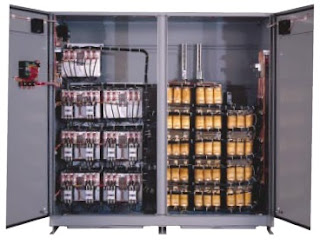Harmonic Filters are used to mitigate the power quality problem known as harmonic waveform distortion. Consequently, they minimize the thermal and electrical stress on the electrical infrastructure, eliminate the risk of harmonics-related reliability issues and allow for long-term energy efficiency and cost savings. Harmonic filters will play a vital role in ensuring a better power quality, especially now that most modern electrical devices are of the nonlinear type.
Basic Types
Harmonic filters can be broadly classified into two basic types:
The so-called hybrid harmonic filter is merely a combination of the passive and active types.
 |
| Harmonic Filters |
Benefits and Functions
A harmonic filter provides the following benefits and performs these functions:
· Supplies connected loads with non-destructive current and voltage waveforms.
· Releases capacity by reducing losses caused by harmonics on lines and transformers.
· Reduces triplen harmonics, which increase the current flowing through the neutral.
· Protects the electrical system by reducing overheating of equipment and/or fire hazards.
· Improves phase current and voltage balance.
· Improves the power factor of nonlinear loads.
· Compliance with the required total harmonic distortion (THD) and total demand distortion (TDD) limits set by international standards organizations such as IEEE and IEC.
Applications
Harmonic Filters are appropriate for electrical power distribution systems that supply significant amount of harmonic-producing loads. Some examples are given below:
Industrial - Adjustable Speed Drives, Arc Furnaces, Arc Welders and HVAC
Commercial - SMPS, UPS Systems, Medical Devices and Data Centers
Residential – Computer equipment, and electronic devices and appliances.
Selection
The selection of harmonic filters is practically based on the intended application and power quality objectives. Generally, the engineer or end-user must weigh the pros and cons of using either an active, passive or hybrid harmonic filter for a certain application. As usual, the decision will depend on the technical and economical aspects involved. Once the filter type is chosen, optimized sizing will follow. In sizing, for example, a passive filter may require the following data:
· Harmonic profile load current
· Fundamental load current
· Harmonic factor of the neutral current
· Detailed Power Quality Studies
· Configuration of the existing or proposed system
On the other hand, active harmonic filter (AHF) sizing depends primarily only on the nonlinear load requirement. In addition, the AHF is modular and relatively less extensive power quality studies are needed.
References:
IEEE 1531-2003. Guide for Application and Specification of Harmonic Filters
Thota, S. (2003). Harmonic Filters Overview – Part 1


No comments:
Post a Comment